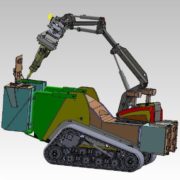 Ancient Romans looked at the remains of birds to decipher the future. Modern people –specifically those in the unmanned industry – look at government roadmaps. What does the latest Department of Defense (DoD) offering tell us about our upcoming prospects?
Ancient Romans looked at the remains of birds to decipher the future. Modern people –specifically those in the unmanned industry – look at government roadmaps. What does the latest Department of Defense (DoD) offering tell us about our upcoming prospects?
No surprises
This most recent roadmap displays excellent quality and workmanship, which reflects the high visibility of unmanned systems and their related activities. Soldiers do well what commanders inspect.
However, in significant ways, there is very little that is new in the most recent Roadmap. Consider the following excerpts:
“The six areas of interest highlighted in this chapter are interoperability and modularity; communication systems, spectrum, and resilience; security (research and intelligence/technology protection (RITP)); persistent resilience; autonomy and cognitive behavior; and weaponry.”
“The perspective establishes that future unmanned systems must
- Provide capabilities more efficiently through such attributes as modularity, interoperability, integration with manned systems, and use of advanced technologies.
- Be more effective through features such as greater automation, improved performance, and flexible use of capabilities.
- Be more survivable in contested environments through improved and resilient communications, increased security from tampering, and system design.
- Reduce manpower requirements to operate and support unmanned systems.”
I haven’t committed the most recent roadmaps to memory, but I am willing to bet, that with the possible exception of “contested environments” (which reflects our “tilt” toward a possible conflict with China), both these excerpts could have appeared verbatim in previous DoD documents.
Interoperability
This doesn’t mean that these priorities should be ignored. For example, despite the enormous obstacles it has encountered, the (DoD) hasn’t given up on interoperability, and has even made some progress. We can expect them to lose their patience with vendors who regard interoperability merely as a threat to their revenue stream.
Simply stating your products are interoperable won’t be enough. No more can we get away with saying, “Sure my proprietary solutions are interoperable! They’ll work with any of my company’s unmanned systems! Of course, you’ll have to pay a license fee.”
To determine how serious your company is about this issue, ask yourself if people in your organization are familiar with:
- UAS Control Segment (UCS) Architecture
- Unmanned Systems Interoperability Profiles (USIPs)
- Service Interface Control Working Groups (ICWGs)
- Service IOPs
Other areas, such as autonomy and teaming with manned assets, are also important. Take a look at your organization’s technological roadmap. Does it target the six areas mentioned in the first excerpt? If it does, you are in a good position to catch the attention of the DoD and potential partners.
The Pacific tilt-a-whirl
“A strategic shift in national security to the Asia-Pacific Theater presents different operational considerations based on environment and potential adversary capabilities that may require unmanned systems to operate in anti-access/area denial (A2/AD) areas where freedom to operate is contested.”
As you are probably aware, our national government has decided not to fight any more land wars in Asia. Instead, we will focus on maritime security. Expect to see more announcements about Unmanned Combat Aerial Vehicles taking off from and landing on aircraft carriers.
The government’s record on predicting what wars it will fight and what equipment it will need is nearly 100%. That is, 100% wrong. Rather than dwell on past mistakes, take a look at Foreign Policy’s Next Year’s Wars. The list of possible major areas of conflicts is depressingly long and extraordinarily diverse.
As Rob Culver, AMREL’s Director of Business Development Programs (DOD) wrote to me about the uncertainty of future needs, “Our military is adapting. The Federal Gov’t and our Planning Programming Budget Execution System (PPBES) are not.”
The priorities listed above, such as interoperability, will always be important, but it would be surprising if our next big military engagement was not surprising. Solution providers who are more agile, and can adapt quickly to changing requirements will be the ones most likely to be favored.
There is a lot of money; no there isn’t
“In fact, the unmanned air domain as described in the 2014 President’s Budget released to the U.S. Congress shows a 33.4% reduction in research, development, test, and evaluation and procurement funding from the previous year.”
In addition to the above cut, the unmanned budget was already decreased by 24% percent from 2012 to 2013. Indeed, the entire 2014 budget for UGV was only $13 million. Since the government is still main driver behind purchases of unmanned systems, and the non-Defense market is still years away from creating significant demand, these figures alone suggest tough times for the industry.
On the other hand, the overall budget news out of Washington has been relatively upbeat. There appears to be real effort to avoid the shutdowns and other budget crises that have plagued us recently. Some cuts to Defense may be avoided. If the two-year budget deal stands, we expect a more stable fiscal environment, which means prime contractors will be more open to spending money on federal projects. The country’s biggest Defense vendor, Lockheed Martin, for example, is expected to revise its financial outlook upward for 2014.
Furthermore, a single year’s budget, as quoted above, may be misleading. Unmanned budgets are expected to increase after 2014. Also, procurement is a long, arduous process, in which multi-years total may be more significant than a single year’s allocation. Consider the funding over the next 4 years for UGVs.
$223.9 million dollars over a 4 year period sounds a lot more promising than the $13 million budgeted just for 2014. It is definitely not too early to start targeting the $47 million available in 2015 or the $66 million projected for 2018.
I asked Rob Culver, who has years experience as a procurement officer for the DoD, his take on the unmanned budget.
“Overall, DoD budget looks good, in spite of initial dip in 2014,” states Rob. “However, uncertainty will rule. There will be more manpower cuts. Congress is reactive not proactive.”
“Times will get better, but the first half of year will be slow and frustrating” he continued. “Don’t expect contracts to primes until June or July. The market will finally kick into gear in October. Expect a busy final quarter of this year.”
Beyond budget
Rob advised not to get overly fixated on the budget, or even the specifics of the Roadmap, but look at general trends. For example, Defense suppliers have always known that years of effort are needed before a Request For Proposal (RFP) is issued, in order to successfully secure an order.
“That’s more true than ever,” states Rob. “Planning and investing one year in advance is already too late.”
He advises that we should expand the kind of markets that we supply. For example, the unmanned industry is a good fit for the ARMY’s Ground Vehicle program. The ARMY has set ambitious goals for automating its vehicles and outfitting them with remote piloting capabilities. Suppliers for unmanned systems are uniquely qualified to furnish these capabilities, whose funding is not found in the Roadmap’s budgets.
There is an old truism that during peacetime the DoD favors quality over speed, while during wars, it wants large quantities immediately. Rob doesn’t believe it still applies. The current DoD wants high quality and they want it now. And they want it economical.
Just like the military, the unmanned industry will have to move fast, get solutions right, adapt quickly to changing situations, and do less with more. You don’t need a roadmap to see that.










